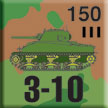150th Panzer Brigade
By Mike Bennighof, Ph.D.
January 2014
 Although the Germans devoted most of their remaining resources to their attack
in the Ardennes forest in December 1944, they still would
face enormously superior Allied forces. To help capture the
bridges over the Meuse River from the unwary Americans, Adolf
Hitler himself suggested the formation of a special tank brigade
equipped with American vehicles and weapons, its troops dressed
in American uniforms. English-speaking soldiers would interact
with any genuine Americans encountered.
Although the Germans devoted most of their remaining resources to their attack
in the Ardennes forest in December 1944, they still would
face enormously superior Allied forces. To help capture the
bridges over the Meuse River from the unwary Americans, Adolf
Hitler himself suggested the formation of a special tank brigade
equipped with American vehicles and weapons, its troops dressed
in American uniforms. English-speaking soldiers would interact
with any genuine Americans encountered.
Hitler selected his favorite SS commando, Otto Skorzeny, to
command the unit. Hitler summoned him on 22 October 1944,
giving him a promotion and the new command. Skorzeny produced
his plan on the 26th, requesting 3,300 men and all available
captured equipment. Though Hitler had woven tales of mountains
of ex-U.S. gear, the Germans managed to find only two Sherman
tanks in their depots, one of which broke down and could not
be repaired (probably the cause of its capture to begin with).
The other broke down on the night before the attack (one must
wonder how much its crew had to do with this).

Otto Skorzeny, uniformed terrorist.
Skorzeny’s new command, designated 150th Panzer Brigade,
instead received 22 PzKpfw V Panther tanks and 14 StuG III
assault guns. All received a coat of green paint (which quickly
began to flake off) and sloppy hand-crafted white stars. About
half (the exact number is unclear) of the Panthers were given
a sheet-metal extension on the rear of the turret that might
make them resemble an American M-10 tank destroyer with the
help of darkness and/or drunken observers.
Volunteers proved hard to come by, and so Army troops from
11th Panzer Regiment were transferred as well as some Luftwaffe
paratroopers. All were to wear pink or blue scarves, and the
tanks were given a large yellow triangle on the rear for identification.
The new brigade moved out on December 16 as part of I SS Panzer
Corps, and promptly became tangled with other units. The poor
march discipline of the hastily-assembled unit made it impossible
to get it to the front, and when two days had gone by without
the brigade seeing any action Skorzeny suggested giving up
the special plan and using his troops as a regular battle
group. Sixth Panzer Army headquarters agreed, and sent them
toward Malmédy for their only action of the campaign.
The hapless SS men did not strike the Americans until the
21st, a day later than planned, by which time the U.S. Army’s
99th Norwegian Infantry Battalion and other units were dug
in and ready for them. The SS men charged, screaming “Surrender
or die!” in English, but had managed to attack the only
non-English-speaking Allied unit in the Ardennes. The baffled
Norwegians simply mowed them down.

One of Skorzeny’s “American” tanks, after
the battle.
A handful of tanks made it into the positions of the 120th
Infantry Regiment’s Company K, but here they were stopped
by a single man. Pvt. Francis Currey, carrying a load of anti-tank
rockets, saw Lt. Albert Snyder knock out one tank with a bazooka,
and then apparently went totally berserk. Currey grabbed Snyder’s
weapon and knocked out three more Panthers by himself, then
fired the rest of his rockets at their accompanying infantry,
killing several and driving off the rest in blind panic.
Skorzeny’s men never recovered from Currey’s attack.
For 150th Panzer Brigade, the war was over. It withdrew behind
18th Volksgrenadier Division and by the 28th had been dissolved.
As a variant for Alsace
1945, the 150th Panzer Brigade sets up stacked with any German unit. When entering an Allied zone
of control, the German player rolls one die. On a result of 4 through 6, the unit may cnotinue moving (providing it has sufficient movement points remaining). On a result of 1, the unit loses a step. You can download the new counter here.
You can order Alsace 1945 here.
|
